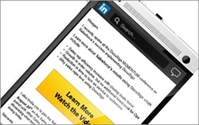LinkedIn Expands Email Marketing To Mobile
- by Mark Walsh @markfwal, March 5, 2014

LinkedIn is extending its Sponsored InMail product to mobile devices as it continues to build up mobile advertising on the professional networking site.
The format, introduced on the desktop in 2009, allows marketers to send targeted email promotions to LinkedIn users. To keep from flooding inboxes with offers and annoying users, LinkedIn limits Sponsored InMail messages to one every 60 days.
With more of its traffic coming from mobile -- 41% -- it’s a natural step for LinkedIn to bring the email marketing tool to devices. The company says more than half of LinkedIn inbox page views now take place in mobile.
According to a Yesmail Interactive study released Tuesday, half of consumers overall read emails exclusively on mobile devices as of the fourth quarter of 2013.
Like its Sponsored Update units that run in users’ news feeds, the company describes Sponsored InMail as a native ad placement. But unlike the former, people receive an alert on their home screen when they get a sponsored email message to make sure they don’t miss the bimonthly ad.
The company pitches Sponsored InMail as a vehicle for generating leads, boosting awareness, sending personalized attention to events and building communities and followers by driving traffic to specific groups on LinkedIn.
The email ads are bought on a cost-per-send basis and allow targeting by criteria including geography, industry, job title and company size.
In a blog post Wednesday, Dan Gonzalez, a senior global product marketing manager at LinkedIn, said LinkedIn has optimized Sponsored InMail for running campaigns across Android devices, the iPhone and the mobile Web.



The interesting question around this move is how the new law in Canada will impact marketing. The Canadian Anti-spam law comes into effect on July 1, 2014 and it DOES apply to non-Canadian companies marketing to Canadians through any online tool.